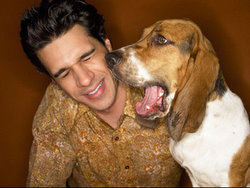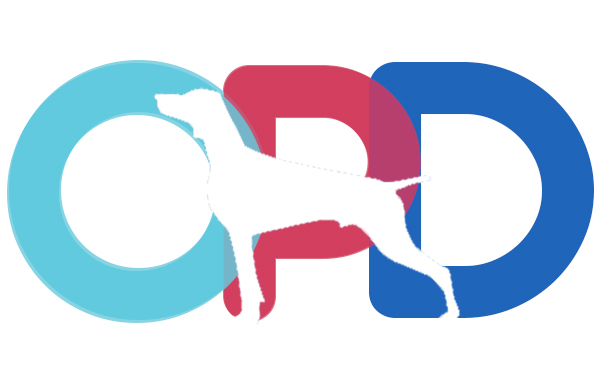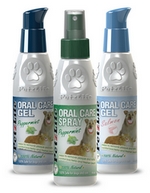Let’s start with you. What happens if you don’t brush your teeth? Plaque starts to build around the gum line and in between the grooves of your teeth and a funky smell begins to follow your words out of your mouth.
Brush at least twice a day with a dentist-recommended toothpaste and we come close to eliminating most of the common human dental problems.
So, why don’t our dogs get the same consideration? We complain that they are the family member with the un-kissable breath but often do nothing to help them combat the problem.Starting today, dog dental hygiene will be a top concern for you…
Common Symptoms of Dog Teeth Care Problems
Common symptoms of dog dental hygiene problems are often similar to humans…

- Bad Breath
- Blood in the saliva
- Broken teeth
- Drooling
- Loss of appetite
- Swollen, bleeding gums
- Yellow-brown tartar at the gum line
If your dog is experiencing any one of these, even a minor one like bad breath, it is likely that your dog teeth care could be improved.
Dog Dental Hygiene – Preventive Care
As with all dog health and wellness related issues, good dog teeth care begins with solid preventive care, including…
- Daily brushing
- Healthy Dog Food Diet
- Exercise
- Regular visits to the veterinarian, which should include an oral check-
up and teeth cleaning. - Discuss your planned teeth-brushing with your vet prior to beginning. If your dog has unhealthy gums or broken teeth, brushing may be painful and you should use gentler options.
“Daily brushing? My dog won’t let me hold her face still for 3 seconds to clean out her eyes, let alone for the amount of time it would take to brush her teeth!”
Brushing Alternative
There are a few good natural products out there that can do the job WITHOUT needing to brush. PetzLife Complete Oral Care is one such product.
Instead of brushing, you just spray or apply the gel (you choose which is easier) a few times each week for preventive care or a couple of times per day for plaque or tartar removal. After each application, wait at least a half hour before allowing your pet to eat or drink anything.
You should start to notice results within a month or so.
We contacted PetzLife to see if they’d give our visitors a better deal, and they agreed to a 20% discount. Their system should automatically do it for you when it sees that you’ve come from Organic Pet Digest. Just in case, the 20% off coupon code is “organic” which can be entered on their site during checkout.
Click here to go to the PetzLife Complete Oral Care discount page.
If you decide to go with the traditional brushing route, the following technique seems to be the most effective:
Dog Dental Hygiene
Shopping List
- Dog Toothbrush
- Dog Toothpaste
- Chew toys
- Teeth-cleaning treats
- Start in your dog’s favorite and most comfortable area and at a time of day when she is the least excited
- Be very slow and gentle. Use as little restraint as possible
- Reward your dog with his or her favorite organic dog treat after each session
Now for the actual steps:
- At first, only briefly hold and look into your dog’s mouth – but do it often.
- Once your dog is comfortable with allowing you to look, start to massage the gums a little. Move in gentle circles around the outside of the gums and teeth. Do this quickly at first, and spend a little more time with each attempt.
- Now it’s time to introduce a brush. Use the same technique, and add a dab of dog toothpaste. We use Triple Pet’s All Natural Toothpaste.
- BE PATIENT – it takes some dogs over a month to get used to it.
Ultimately you want your dog to get excited when the tooth brush comes out. Believe it or not, this can eventually be fun for them! So remember:
- Be gentle!
- Go at your dog’s own pace.
- Reward your dogs with a treat, trip outside, game of fetch or whatever they like most.
What parts of your dog’s mouth should you focus on?
Plaque build-up is most common on the upper teeth, so that is always the place to start. Dogs only produce plaque on the outside of their teeth and gum line, so do not worry about brushing the inside.
To compliment your dog dental hygiene efforts, you should also consider:
- A teeth-cleaning dog organic treat, bone or toy
- Dog mouthwash
Certain dog treats, bones and chew toys can help fight tartar buildup and improve bad breath as long as they are provided daily after meals. They also provide good exercise for your dog’s jaw.
Which treats are best for dog dental hygiene?
Consider an organic treat with the Veterinary Oral Health Council’s (VOHC) logo. The VOHC has developed a protocol for dog treat manufacturers to follow to ensure that their products effectively reduce plaque and tartar.
Greenies Smart-Treats (pictured above right) is our top choice from the VOHC’s list. Click here for the rest of the VOHC-Accepted products.
Mouthwash sprays help kill bacteria and may actually heal damaged gum tissue. As always, it is a good idea to check with your veterinarian before trying any new product.
Taylor Tips!I like to be wrapped in a soft blanket when I get my teeth brushed. It calms me down and reminds me to sit still. |
More Severe Dog Dental Hygiene Problems
Suggestions for Removing Plaque from Dogs’ Teeth
To remove plaque from your dog’s teeth, try Healthy Mouth drops in his water, Plaque Off powder in his food (from seaweed) and dental chews or tartar control treats (as mentiond above) for him to chew.
You should contact your vet if your dog is experiencing any of the more severe symptoms listed towards the top of this page such as…
- Blood in the saliva
- Broken teeth
- Loss of appetite
- Swollen, bleeding gums
These symptoms could mean your dog has one of the following dog dental hygiene problems:
- Periodontitis – Periodontal disease is the most common dental problem for dogs. It is caused by plaque (a mixture of food remnants, cell mucus, saliva and bacteria) and can be identified by a milky-white film on the gums and teeth. When mixed with saliva, plaque turns into tartar which cements itself to your dog’s teeth. It also eats away at the bone that holds your dog’s teeth by working its way underneath the gums.
- Tooth fractures are the second most common problem in dog dental hygiene. They are caused by simply biting down on something hard such as bones, sticks, rocks and some nylabone toys and can lead to infection inside the tooth (called endodontic disease). Avoid tooth fractures by buying appropriate dog chew toys.
- Gingivitis is a gum disease that causes inflammation of the gum tissue. It can lead to periodontitis, bone loss and eventually loss of teeth.
If your dog is experiencing any of these problems there will most likely be a solution. Dogs have most of the same options as human dental care, so regardless of the problem a good vet will guide you down the right path.
You can also review pictures and questions submitted by other visitors in our My Online Vet Ask-A-Vet Library section on Dog Mouth, Teeth and Gums.
Do you believe in holistic pet care? Do you believe in holistic pet care? If so, please tell your friends about us at Organic Pet Digest. Thank you for supporting our efforts!
Also see…
- The Best Dog Dental Kit (along with 3 other essential grooming kits)
- Ask a Vet Online Library – Dog Mouth, Teeth & Gums Section
- Benefits of Apple Cider Vinegar
- Dog Vet Care Comparison

